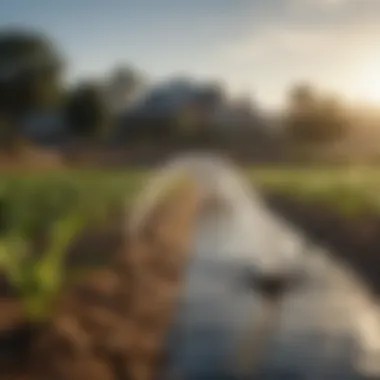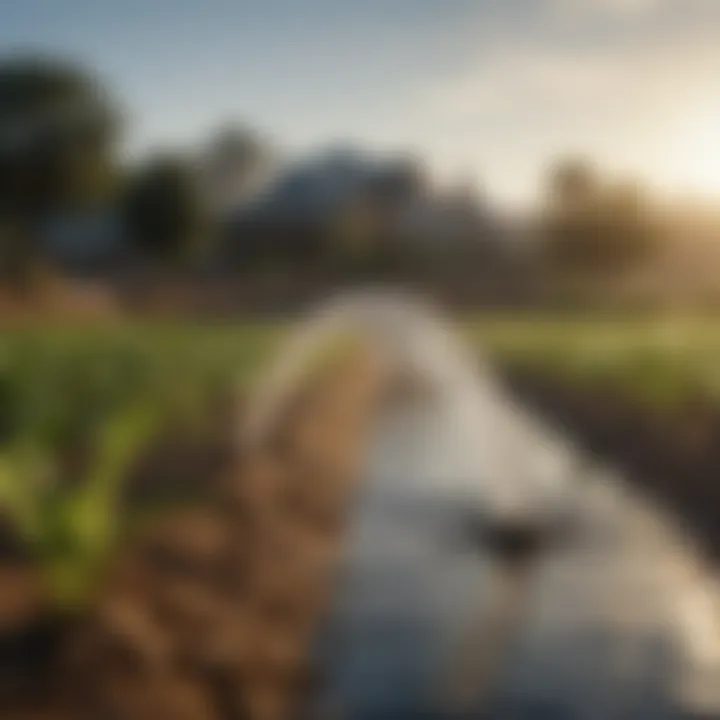Maximize Crop Yield with Free Irrigation Calculators


Intro
Irrigation plays a critical role in agriculture. The efficient management of water resources can significantly impact crop yield and sustainability. Free irrigation calculators offer a solution for farmers and agricultural professionals seeking to optimize water use. This article will delve into the nuances of these calculators, their applications, and practical integration into farming practices.
Overview of the Topic
Definition and Importance
Irrigation calculators are tools designed to help farmers determine the optimal amount of water needed for their crops. They take into account various factors such as soil type, crop species, and local climate conditions. Accurate irrigation management is essential not only for maximizing yields but also for promoting water conservation.
Current Trends
In recent years, there has been a growing trend towards using technology in agriculture. Precision farming, which incorporates data-driven decision-making, has gained popularity. The rise of smartphones and internet access has made it easier for farmers to find and use free irrigation calculators available online. Moreover, the increasing focus on sustainable practices has highlighted the need for efficient water management solutions.
Key Techniques and Practices
Step-by-Step Guide
- Identify Your Crop Needs: Understanding the specific water requirements of your crops is crucial.
- Choose the Right Calculator: There are several free tools online, such as the USDA’s Irrigation Calculator and various mobile applications. Look for features that suit your farming needs.
- Input Relevant Data: This includes soil moisture, rainfall data, and crop type.
- Analyze Output: The calculator will provide you with recommended irrigation schedules and amounts.
- Implement and Monitor: Apply the recommendations and monitor the results. Adjust as necessary based on feedback from the crops.
Tools and Equipment Needed
To effectively utilize irrigation calculators, consider the following:
- Access to Internet: Ensure reliable internet connectivity.
- Smartphone or Computer: For ease of use when entering data into the calculators.
- Soil Moisture Sensors: Optional but beneficial for real-time data on soil conditions.
Challenges and Solutions
Common Obstacles
Farmers may face various challenges when implementing irrigation calculators, including:
- Data Accuracy: Incorrect input can lead to suboptimal irrigation recommendations.
- Lack of Understanding: Some calculators may seem complex, discouraging their use.
- Changing Conditions: Weather and soil conditions can fluctuate, impacting water needs.
Innovative Solutions
To overcome these barriers, farmers can adopt several strategies:
- Training and Education: Participate in workshops or online tutorials to gain familiarity with tools.
- Frequent Updates: Regularly check for updated versions of calculators that may include improved algorithms.
- Community Support: Engage with other farmers through forums, such as those on Reddit, to share experiences and tips on using these calculators.
The integration of technology in farming continues to be a transformative element. Access to free irrigation calculators is crucial for farmers looking to adopt sustainable practices that enhance productivity while conserving water.
By implementing these calculators and utilizing the insights they provide, farmers will not only enhance their operations but also contribute to a more sustainable agricultural system. The relative ease of access to these tools allows for a more informed approach to resource management in farming.
Preamble to Irrigation Management
Effective irrigation management is a central component for successful agriculture. It governs how water resources are utilized, ensuring that crops receive the right amount of moisture to thrive. The management strategies put into place can significantly affect not only crop yields but also the sustainability of water usage. As we witness changing climate patterns and increasing water scarcity, mastering irrigation is vital for modern farming practices.
Significance of Effective Irrigation
Effective irrigation serves multiple essential purposes. First, it enhances crop yield. With precise water management, farmers can ensure that plants receive adequate hydration for optimal growth. This can lead to increased harvest sizes and better quality produce. Furthermore, effective irrigation contributes to resource conservation. Taking a strategic approach to irrigation helps minimize water waste, which is increasingly important in areas facing drought conditions.
In addition, efficient irrigation practices can improve soil health. Appropriate watering levels can prevent soil salinization and erosion, promoting long-term sustainability. Farmers who adopt efficient irrigation practices report not only better results but also savings in operational costs over time.
Challenges in Traditional Irrigation Methods
Traditional irrigation methods, while widely used, present numerous challenges that can hinder successful crop production. One notable issue is the inefficiency of water application. Systems like flood irrigation often lead to significant runoff and evaporation losses, meaning less water gets to the plants.
Moreover, traditional methods may not optimize water distribution across different areas of a field. This can result in overwatering in some areas while others suffer from dryness, leading to poor crop performance. There is also a lack of flexibility in traditional systems. As crops’ needs change, adapting irrigation schedules and volumes can be challenging.
Finally, labor needs add to the complexity. Many traditional irrigation systems require extensive hands-on management, which can be resource-intensive. By understanding these challenges, farmers can explore alternative solutions, such as using irrigation calculators. These tools can simplify calculations and enhance effectiveness by automating many aspects of irrigation management.
Understanding Irrigation Calculators
Understanding irrigation calculators is essential for modern agriculture, especially as water resources become scarcer. These tools facilitate effective irrigation management, ensuring that crops receive the proper amount of water without wastage. Farmers and agricultural professionals can benefit immensely from using these calculators, particularly when it comes to maximizing crop yield and minimizing water consumption. This section will delve into the definition, purpose, and various types of irrigation calculators that are available.


Definition and Purpose
Irrigation calculators are online or software-based tools designed to assist farmers in determining the necessary amount of water their crops need. The primary purpose of these calculators is to optimize irrigation practices, promote water conservation, and enhance overall crop productivity. By inputting factors such as crop type, soil conditions, and local environmental variables, users can obtain precise irrigation guidelines tailored to their specific agricultural scenario. This approach not only aids in achieving optimal growth conditions for plants but also plays a crucial role in sustainable agriculture.
Types of Irrigation Calculators
Different types of irrigation calculators cater to various irrigation methods, each with unique functionalities and advantages. The following outlines three prevalent types:
Drip Irrigation Calculators
Drip irrigation calculators are designed specifically for optimizing the use of drip irrigation systems. These systems deliver water directly to the root zones of plants, which reduces evaporation and runoff. A key characteristic of drip irrigation calculators is their ability to take into account the specific flow rates of emitters and the spacing between plants. As a result, they are a beneficial choice for water conservation efforts.
The unique feature of these calculators is their focus on soil moisture levels. They can provide recommendations based on real-time soil data, which leads to more accurate watering schedules. However, the disadvantage may arise from the complexity of setup for new users unfamiliar with drip systems.
Sprinkler Irrigation Calculators
Sprinkler irrigation calculators assist in managing systems that distribute water through overhead spraying. One major advantage is the ease of setup, making them a popular choice among farmers. The key characteristic of these calculators lies in their ability to factor in wind conditions, which significantly impact water distribution. A unique feature is the calculation of irrigation uniformity, ensuring that every part of the field receives adequate coverage. However, a potential disadvantage is the greater risk of evaporation losses in hot climates, requiring users to adjust calculations accordingly to maximize efficiency.
Surface Irrigation Calculators
Surface irrigation calculators pertain to traditional methods where water flows over the soil surface. They are particularly useful in analyzing field shapes and slopes to determine appropriate water distribution methods. The key characteristic of these calculators is their ability to simulate various irrigation scenarios based on soil infiltration rates and runoff.
This makes them a valuable option for farmers utilizing these classic irrigation techniques. Their unique feature is the ability to generate step-by-step irrigation schedules that consider both timing and volume of water. However, a downside could be their reliance on more variable weather conditions, making precise water management more challenging.
In summary, understanding these different types of irrigation calculators is important for effective irrigation management. They offer invaluable tools for farmers aiming to improve water efficiency and crop production. With their varied functionalities, selecting the appropriate calculator based on the farming method and specific needs can lead to significant improvements in agricultural practices.
Features of Free Irrigation Calculators
The features of free irrigation calculators play a crucial role in their effectiveness for farmers and agricultural professionals. These tools are not merely about the calculations; they encompass various aspects that enhance usability and provide meaningful insights for effective irrigation management. In this section, we will delve into three key features: user interface and accessibility, data input requirements, and output analysis and reports. Each element contributes to the overall functionality, making these calculators indispensable for modern sustainable agriculture practices.
User Interface and Accessibility
A well-designed user interface is vital for ensuring that farmers can navigate the irrigation calculator easily. Accessibility is not only about visual appeal but also about functionality. A simple layout, intuitive buttons, and clear instructions can significantly improve a user's experience. Many calculators are now designed responsively, allowing them to be used seamlessly on various devices like smartphones, tablets, and computers. This flexibility means that farmers can access vital information whether they are in the field or at home.
Supporting multiple languages can also enhance accessibility for non-native English speakers, making it easier for diverse user groups to utilize these tools effectively.
Data Input Requirements
Understanding what data input is necessary for these calculators is essential. Generally, users must provide specific details about their agricultural setup. Common inputs include:
- Soil type and moisture levels
- Crop types and growth stages
- Irrigation system types
- Local weather conditions, including rainfall and temperature
The accuracy of the output depends on the quality of the data entered. Thus, farmers should ensure that they have the most recent and accurate information available. Some calculators may also link to external databases, allowing real-time updates and providing an efficient way to gather necessary data.
Output Analysis and Reports
Once the data has been input, the next critical feature is the output. Good irrigation calculators provide comprehensive analysis reports that are clear and actionable. Outputs may include estimations of water needs, scheduling suggestions, and potential savings in water usage. The best calculators will present this data visually, using graphs or charts, which makes interpretation easier.
Additionally, reports may suggest adjustments based on changing conditions or specific crop requirements, helping users to optimize their irrigation practices. This analysis not only saves water but also promotes higher crop yields, aligning with sustainable agricultural practices.
The right irrigation calculator can be a game changer in managing water resources efficiently, ultimately benefiting both farmers and the environment.
Popular Free Irrigation Calculators Online
The role of online irrigation calculators cannot be overstated. They provide vital support to farmers and agricultural professionals in making informed decisions regarding their irrigation needs. With various options available, choosing the right calculator can significantly influence water usage and crop yield. Therefore, understanding the popular free tools online helps users navigate their options effectively.
Overview of Top Online Tools
Several irrigation calculators stand out due to their unique features and user-friendly interfaces. These tools aim to simplify the irrigation planning process. Some noteworthy calculators available online include:
- Irrigation Scheduler by the USDA: This tool assists farmers in determining optimal irrigation schedules based on weather conditions and crop needs.
- CropWat by FAO: Widely recognized, this application calculates crop water requirements using climatic data, soil properties, and crop information.
- Drip Irrigation Calculator by the Drip Irrigation Association: This is designed specifically for drip systems, providing detailed insights on emitter spacing and flow rates.
Each of these calculators offers distinct advantages, addressing various irrigation methods and user requirements. The ease of access to these resources plays a crucial role in promoting better agricultural practices.
Comparative Analysis of Features
When evaluating different irrigation calculators, several key features warrant consideration:
- User Interface: The simplicity of navigation can greatly enhance the user experience. Tools with clear layouts allow farmers to input data easily and extract results without unnecessary complications.
- Data Accuracy: Reliable calculators employ real-time data, ensuring that users receive up-to-date information that reflects actual conditions on the ground.
- Output Variety: A good calculator should not only provide basic recommendations but also offer detailed reports on water requirements and irrigation schedules. This breadth of output enables farmers to make well-informed decisions.
- Customization Options: The ability to adjust parameters based on local conditions or specific crop needs improves the overall utility of the tool.


Overall, the effectiveness of an irrigation calculator largely depends on its features and how they align with the user's agricultural goals.
How to Choose the Right Irrigation Calculator
Choosing the right irrigation calculator is crucial for modern agricultural practices. With so many options available, a thoughtful approach can lead to enhanced efficiency and sustainable farming. The right calculator will align with specific farming needs and maximize water use efficiency. There are several elements to consider, along with the benefits of making an informed choice.
Assessing Specific Agricultural Needs
Every farm is unique. Therefore, assessing specific agricultural needs is the first step in choosing an irrigation calculator. It's essential to evaluate the following factors:
- Crop Type: Different crops have unique water requirements. Understanding these needs helps in selecting a tool that can cater to them effectively.
- Soil Conditions: The soil type affects how water is absorbed. Consider calculators that can account for local soil characteristics.
- Climate Factors: Rainfall patterns and humidity levels vary by region. The chosen calculator should adapt to these conditions to provide accurate irrigation schedules.
Assessing these factors ensures that the calculator selected addresses the unique conditions of the farm. Utilizing tools customized for specific environments can lead to more effective water distribution and improved crop health.
Evaluating User-Friendliness
A user-friendly irrigation calculator is vital for encouraging regular use by farmers and agricultural workers. Evaluating user-friendliness includes the following considerations:
- Interface Design: The layout should be intuitive. Farmers should be able to navigate the tool easily without extensive training.
- Data Input Simplicity: Ideally, the calculator should minimize the amount of data needed from the user. A streamlined process encourages adoption and effective usage.
- Feedback Mechanism: The best tools offer instant feedback. Features like graphs or summary reports can help users quickly understand their irrigation needs.
By focusing on user-friendliness, farmers are more likely to use the calculators diligently. The effective use of these tools can lead to significant improvements in irrigation practices.
In summary, selecting the right irrigation calculator hinges on understanding specific agricultural needs and ensuring the tool is user-friendly. By prioritizing these factors, farmers can enhance their productivity while promoting sustainable water usage.
Practical Applications of Irrigation Calculators
Irrigation calculators play a vital role in modern agriculture, providing farmers with the tools to optimize water usage while maximizing crop yield. These calculators are essential for planning and managing irrigation in a way that aligns with sustainable practices. By using these tools effectively, farmers can achieve efficiency that goes beyond simple estimates. Instead, they allow for precise calculations tailored to specific crops, soil types, and climatic conditions, making them indispensable in today’s farming landscape.
Case Studies from Farmers
Real-world applications of irrigation calculators reveal their significance. For instance, a farmer in California adopted a free drip irrigation calculator to adjust his watering schedule based on weather forecasts and soil moisture data. This approach led to a 25% reduction in water usage while simultaneously increasing his almond crop yield. The environmental benefits were measurable and significant, showcasing how such calculators can save resources and enhance productivity.
Another interesting case is a cooperative of smallholder farmers in India, who collectively used a sprinkler irrigation calculator. They assessed crop water requirements differently throughout the growing season. This collaboration resulted in a 30% increase in the efficiency of their irrigation practices, directly contributing to improved harvests and incomes. Farmers reported feeling empowered by the data-driven approach, as it not only improved their yields but also instilled greater confidence in their farming decisions.
Integration with Other Farming Tools
The full potential of irrigation calculators shines when integrated with other farming tools. For example, many farmers utilize soil moisture sensors alongside irrigation calculators. The data retrieved from these sensors can be fed directly into the calculators for optimized irrigation scheduling. This synergy enhances decision-making processes, allowing farmers to react to on-ground conditions promptly.
Similarly, some farmers have integrated their irrigation calculators with mobile applications that track weather patterns. Such systems alert users about upcoming rainfall events, allowing adjustments to the irrigation plan to prevent overwatering. This connection between various tools ensures that farmers not only rely on calculations but also remain responsive to immediate environmental changes.
Integrating these tools fosters a holistic approach to farm management. It encourages data-driven strategies that enhance productivity while promoting conservation. The collaborative use of different resources reflects a trend of modernization in agriculture, where technology and traditional practices coexist harmoniously.
"Utilizing irrigation calculators not only saves water but also enhances crop yields and supports sustainable farming practices."
By understanding the practical applications of these irrigation calculators, farmers can position themselves for success in an increasingly resource-conscious agricultural sector.
Benefits of Using Irrigation Calculators
Irrigation calculators serve as a critical resource for farmers, providing a scientific approach to water management. The advancement of technology has enabled the development of various algorithms and tools that can significantly enhance agricultural practices. Utilizing these calculators brings forth numerous benefits, impacting efficiency, crop yield, and sustainability.
Enhanced Water Efficiency
One of the most significant advantages of using irrigation calculators is the enhancement of water efficiency. Water is a precious resource in agriculture, and its management directly affects both production costs and environmental sustainability. Irrigation calculators help farmers to:
- Determine Precise Water Needs: By analyzing various factors such as soil type, crop variety, and weather conditions, these tools can offer tailored recommendations on water requirements. This precision prevents over-irrigation and under-irrigation, optimizing water usage.
- Reduce Runoff and Wastage: Effective irrigation planning minimizes runoff, which can lead to soil erosion and nutrient loss. Calculators aid in planning schedules that align with crop growth stages, ensuring water is effectively utilized by plants.
- Conserve Energy: Efficient irrigation practices lower energy consumption in pumping water. By using the right amount of water at the right time, farmers can reduce their energy bills associated with irrigation systems.
Using irrigation calculators not only conserves water but also supports sustainable practices. Farmers can meet their objectives while ensuring they do not compromise future water availability.
Higher Crop Yields
The impact of irrigation calculators on crop yields cannot be overstated. By providing scientifically-backed irrigation strategies, these calculators help in:
- Improving Crop Quality: Consistent and adequate moisture levels lead to healthier plants. Quality of produce improves significantly, which is essential for market demands.
- Increasing Productivity: Crops that receive an appropriate amount of water tend to grow faster and yield more. Efficient irrigation is pivotal during critical growth periods.
- Reducing Stress on Plants: Under or overwatering can stress plants, causing stunted growth or potential crop failure. Irrigation calculators mitigate these risks, ensuring optimal irrigation practices are followed.
Overcoming Barriers to Adoption


The adoption of irrigation calculators is crucial in promoting efficient water usage and enhancing agricultural productivity. However, several barriers must be addressed to facilitate widespread use among farmers. Understanding these obstacles is important for developing strategies that can fully leverage these tools, ultimately fostering sustainable agriculture.
Technological Challenges
One significant challenge is the level of technology adoption among farmers. Many farmers, especially in rural areas, may lack access to reliable internet connections or smart devices necessary for using online calculators. This can hinder the ability to gather real-time data essential for accurate calculations. Farmers may also be unfamiliar with new technologies, leading to reluctance in utilizing digital solutions. Training programs tailored to teach farmers how to use these calculators effectively can bridge this gap.
Additionally, the design of the irrigation calculators should be user-friendly. If the interface is complex, it can deter potential users. Hence, developers need to focus on creating intuitive designs. Simplified navigation and straightforward input methods can significantly enhance the user experience.
Cost Implications
While many irrigation calculators are free to access, there are indirect costs that can affect their adoption. For instance, farmers might need to invest in devices or internet services to use these tools effectively. These costs can be a barrier, particularly for small-scale farmers operating on tight budgets. Even though calculators can potentially lower water usage and increase yield, the initial financial burden of technology adoption can deter practical use.
Moreover, some calculators may offer premium features or additional services requiring subscriptions. Farmers need to evaluate whether the benefits of these premium features justify the costs. Educational initiatives must emphasize the long-term savings and increased efficiency that these tools can facilitate, helping farmers understand that the initial costs may pay off in the long run.
By addressing both technological challenges and cost implications, stakeholders can create a more conducive environment for the adoption of irrigation calculators.
Future Trends in Irrigation Technology
The landscape of agriculture is evolving rapidly, and this change significantly impacts irrigation practices. With increasing demands on food production and the necessity to conserve water, future trends in irrigation technology are becoming crucial. Understanding these trends is imperative for farmers seeking sustainable solutions. This section delves into two pivotal trends: integrating smart technology and emerging software solutions.
Integrating Smart Technology
Smart technology integration is transforming irrigation systems. This technology includes the use of sensors, automation, and data analytics. Farmers can monitor soil moisture levels and crop needs in real-time. For example, soil moisture sensors determine when irrigation is necessary. These devices provide accurate data, allowing precise water application.
Benefits of smart technology:
- Efficient Water Use: Reducing water waste is paramount. By applying water only when needed, farmers conserve resources.
- Cost Savings: Less water use translates to lower water bills, improving overall farm profitability.
- Improved Crop Health: Timely irrigation promotes optimal growth conditions, leading to better yields.
Farmers must consider several factors when adopting this technology:
- Initial Investment Costs: While costs can be high, long-term savings often justify the expense.
- Training Needs: Farmers may require education on how to utilize these systems effectively.
"The future of irrigation is not just about water but using technology to optimize every resource on the farm."
Emerging Software Solutions
Software solutions are increasingly vital in irrigation management. Many farmers are turning to tailored applications that allow for precise irrigation scheduling and management. These applications utilize algorithms to analyze various factors affecting irrigation, such as weather forecasts, crop type, and soil conditions.
Key features of emerging software include:
- Cloud-based Platforms: This allows easy access to data from multiple devices, ensuring farmers can make informed decisions on-the-go.
- Data Analytics: Analysis of historical data helps in predicting irrigation needs and optimizing schedules over time.
- User Customization: Many applications now offer features that cater to the specific needs of farmers, making technology more accessible.
The consideration of software solutions should also involve:
- Compatibility with Existing Systems: Farmers should ensure software can integrate into current practices.
- Ongoing Support: Reliable customer support is essential for resolving issues and maintaining systems effectively.
Ending
The conclusion serves as a crucial pivot point in any comprehensive guide. In this article, it encapsulates the essence of utilizing free irrigation calculators for sustainable agriculture. These tools have emerged as significant resources for farmers aiming to optimize water usage while maximizing crop yield.
First, the essence of effective irrigational prowess becomes evident. By summarizing preceding insights, the conclusion highlights the importance of sophisticated yet user-friendly irrigation calculators. With an awareness of their features and practical applications, farmers can make informed decisions that directly impact their productivity and sustainability.
Second, the conclusion emphasizes the salient benefits of irrigation calculators. They serve as an intersection of technology and agriculture, fostering a more data-driven approach to irrigation management. By incorporating such tools, farmers can not only ensure that they use resources judiciously but also contribute to long-term environmental stewardship.
Additionally, it is important to reflect on the considerations that surround the adoption of these innovations. Farmers must assess their specific needs against the available options. Some may experience resistance to technology due to perceived complexity, while others may view financial implications as a barrier. Thus, the conclusion reiterates the necessity of understanding both the benefits and potential challenges when integrating these calculators into daily practices.
“A comprehensive understanding of these tools can lead to not just individual success but also collective advancements in sustainable agriculture.”
In sum, the conclusion ties the article's threads together. By adequately weighing the importance of irrigation calculators, acknowledging their advantages, and recognizing the factors affecting their adoption, we empower farmers to engage with these tools mindfully and effectively.
Summary of Key Insights
In this article, several insights have been shared regarding the role of free irrigation calculators in sustainable agriculture. Here are the key takeaways:
- Importance of Accurate Management: Effective irrigation directly correlates with improved crop yields and water conservation.
- Diversity of Tools: Various types of calculators are available, each serving specific irrigation methods like drip, sprinkler, and surface irrigation.
- User Accessibility: Many free calculators present a user-friendly interface, simplifying data input and analysis.
- Real-World Applications: Case studies demonstrate practical benefits seen by farmers who utilize these tools.
- Future Trends: Smart technology is poised to further enhance irrigation practices in upcoming years.
Call to Action for Farmers
Farmers should actively consider implementing irrigation calculators in their practices. Here are a few actionable steps to take:
- Evaluate Your Needs: Understand your specific watering requirements and challenges.
- Research Available Tools: Explore the popular free irrigation calculators discussed in this guide.
- Test Tools: Start using a few calculators that seem to meet your needs and assess their usability and impact.
- Monitor Progress: Track changes in water usage and crop yield to understand the effectiveness of these tools.
- Engage with Community: Share experiences and insights with fellow farmers to enhance collective knowledge on effective irrigation practices.
By adopting irrigation calculators, farmers can take a significant step toward enhancing their practices and contributing to sustainable agricultural methods.



